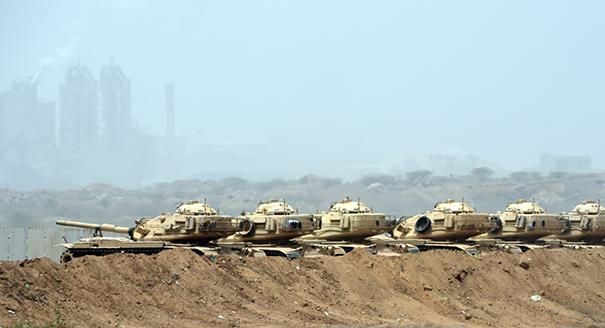The impact of Yemen’s long-running war is being felt not only inside the country, but also in neighboring Saudi Arabia. New developments and the changing dynamics of the conflict have had major security, social, and economic consequences for Saudis as well as Yemenis, especially inhabitants of the southern border area. While rumored negotiations between Saudi Arabia and Ansar Allah, better known as the Houthi movement, could result in political and military arrangements, the impact of events on the border will continue to shape Saudi public opinion long after the war is over.
Since Riyadh intervened militarily in Yemen in 2015, Saudis have actively discussed developments there on social media, reflecting growing public interest in Yemeni affairs. This has been accompanied by ongoing, wide-ranging debates between Yemenis and Saudis over the details and trajectory of the war and how the Saudi intervention is seen by Saudi society. Most Saudi activists have adopted a similar discourse to that of the Saudi state, partly due to government censorship and intense monitoring of social media platforms, precluding any opposing voices. However, the level of debate shows how much attention Saudis have paid in recent years to news from Yemen, which has had a direct impact on their lives.
The economic costs of Saudi involvement in the conflict alone have had major effects on Saudi society, in the form of tax hikes, raised fees for various services, and higher fuel prices. The conflict has also sparked a string of Houthi missile attacks against targets inside Saudi territory, sowing fear among ordinary Saudis and prompting many to start following the news from Yemen more closely.
Totally forbidden from criticizing their government or critiquing its policies, Saudis writing on the war have focused on the country’s enemy and limited their criticism of Saudi-backed actors in Yemen to questioning their seriousness and ability to achieve victory. The situation in Yemen has brought to prominence new Saudi writers, who have treated the subject as a safe topic for political commentary—provided that they adopt the official narrative.
Prior to the war, Yemen received hardly any attention in Saudi life, especially in light of how difficult the Saudi state has made it for Yemenis to enter the country over the past two decades. But things have changed because of the conflict, and Saudi writers and activists have emerged to meet public demand for a narrative to explain the war. Many Yemeni media figures covering the conflict have also gained a following among the Saudis, while clerics have used mosques and religious gatherings to promote the official discourse around it. This narrative has played up Saudi national identity and the ruling family’s ability to manage the conflict. Saudi media outlets have also used events in Yemen to promote the concept of the upstanding Saudi citizen, loyal to his country and its rulers.
The kingdom’s weak spot in this regard is its territory along the Yemen border, where the war has changed security arrangements and demography. When the war broke out in 2015, the Saudi government moved many residents of villages near the border to cities deeper inside Saudi Arabia, essentially turning the region into a buffer zone. This zone extends into Yemeni territory along the border, to a depth of between 10 and 40 kilometers toward Houthi-controlled territory. The goal of this was to prevent incursions into Saudi Arabia, especially as land clashes with the Houthis have dragged on.
This shift in Saudi strategy in its southern region has had major repercussions for tribes along the frontier. Before it engaged the Houthis in military conflict, Saudi Arabia relied heavily on these tribes, both inside Saudi and Yemeni territory, to secure the long border. But Houthi military operations on the Yemeni side, with cooperation from some Saudi elements due to social and sectarian links, pushed Riyadh into a brief conflict with the Houthis in 2009. This revealed the fragility of the region’s security situation and prompted Saudi Arabia to invite the Yemeni military to fight the Houthis from Saudi territory, backed by Saudi air strikes.
Throughout the current conflict Riyadh has relied on Yemeni conscripts—by some estimates numbering as many as 60,000 fighters—distributed across various fronts along the border. However, these fighters only make up the first line. Behind them are a multitude of military and security forces charged by the kingdom with securing its territories. Saudi Arabia has lost dozens of troops in the area due to clashes and artillery fire emanating from Houthi-held areas.
As many as half the Saudi troops lost in these clashes hail from the southwestern border region, especially Jizan, upon whom Riyadh has relied heavily. These casualties have naturally had a social impact. Despite Saudi glorification of soldiers sacrificing their lives to guard the frontier, the losses have been deeply felt nationwide, especially in contrast to the stability that had reigned in previous decades.
Fighting in certain border regions has also forced the closure of markets once vital to local economies. The closure of major border crossings in the Tuwal district has caused major economic losses for Saudis living in surrounding areas. Traffic that used to cross into Yemen from there has moved instead to the Wadieh crossing in the Najran region, which leads into an area controlled by the Yemeni government opposed to the Houthis. These areas have seen an economic rebound thanks to the surge in cross-border trade, especially with the anti-Houthi coalition’s partial blockade of Yemeni ports and crossing points. Residents of Najran have benefitted from this economic shift and the influx of Yemeni investment in areas close to the Wadieh crossing.
The displacement of residents from some pockets of border territory and the rise of economic opportunities in others have led to the creation of new communications channels between these regions, as well as a growth in unofficial traffic across the 1,400-kilometre border with Yemen, which is hard to control.
The war has shown that residents of Saudi Arabia’s southern cities and villages have not been shielded from the repercussions of Riyadh’s intervention. The conflict has brought changes to the way that Saudis think, which will remain strongly present in the coming years. Even after the war ends, Saudi Arabia will face many domestic problems born of the long conflict in Yemen.







